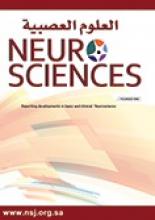Research ArticleOriginal Article
Open Access
Pattern and etiology of early childhood epilepsy: An Experience at a tertiary care University Center
Amal Y. Kentab, Shumukh Al Bulayhi, Muddathir H. Hamad, Ali Al Wadei and Fahad A. Bashiri
Neurosciences Journal October 2022, 27 (4) 244-250; DOI: https://doi.org/10.17712/nsj.2022.4.20220001
Amal Y. Kentab
From the Division of Pediatric Neurology (Kentab, Al Bulayhi, Hamad, Al Wadei, Bashiri), Department of Pediatrics, King Khalid University Hospital, King Saud University Medical City, and from the Department of Pediatrics (Kentab, Bashiri), College of Medicine, King Saud University, and from the Department of Pediatric Neurology (Al Wadei), National Neuroscience Institute, King Fahad Medical City, Riyadh, Kingdom of Saudi Arabia
MDShumukh Al Bulayhi
From the Division of Pediatric Neurology (Kentab, Al Bulayhi, Hamad, Al Wadei, Bashiri), Department of Pediatrics, King Khalid University Hospital, King Saud University Medical City, and from the Department of Pediatrics (Kentab, Bashiri), College of Medicine, King Saud University, and from the Department of Pediatric Neurology (Al Wadei), National Neuroscience Institute, King Fahad Medical City, Riyadh, Kingdom of Saudi Arabia
MDMuddathir H. Hamad
From the Division of Pediatric Neurology (Kentab, Al Bulayhi, Hamad, Al Wadei, Bashiri), Department of Pediatrics, King Khalid University Hospital, King Saud University Medical City, and from the Department of Pediatrics (Kentab, Bashiri), College of Medicine, King Saud University, and from the Department of Pediatric Neurology (Al Wadei), National Neuroscience Institute, King Fahad Medical City, Riyadh, Kingdom of Saudi Arabia
MDAli Al Wadei
From the Division of Pediatric Neurology (Kentab, Al Bulayhi, Hamad, Al Wadei, Bashiri), Department of Pediatrics, King Khalid University Hospital, King Saud University Medical City, and from the Department of Pediatrics (Kentab, Bashiri), College of Medicine, King Saud University, and from the Department of Pediatric Neurology (Al Wadei), National Neuroscience Institute, King Fahad Medical City, Riyadh, Kingdom of Saudi Arabia
MDFahad A. Bashiri
From the Division of Pediatric Neurology (Kentab, Al Bulayhi, Hamad, Al Wadei, Bashiri), Department of Pediatrics, King Khalid University Hospital, King Saud University Medical City, and from the Department of Pediatrics (Kentab, Bashiri), College of Medicine, King Saud University, and from the Department of Pediatric Neurology (Al Wadei), National Neuroscience Institute, King Fahad Medical City, Riyadh, Kingdom of Saudi Arabia
MD
References
- 1.↵
- Alonazi NA,
- Alnemri A,
- El Melegy E,
- Mohamed N,
- Talaat I,
- Hosny A, et al.
- 2.↵
- 3.↵
- Mohamed S,
- El Melegy EM,
- Talaat I,
- Hosny A,
- Abu-Amero KK.
- 4.↵
- Cross JH.
- 5.↵
- 6.↵
- Sahu PK,
- Mishra D,
- Juneja M,
- Taneja K.
- 7.↵
- Zupanc ML.
- 8.↵
- 9.↵
- Poudel P,
- Kafle SP,
- Pokharel R.
- 10.
- Murthy JMK,
- Jaiswal SK,
- Reddy MP,
- Srikrishna S.
- 11.
- Sharma S,
- Anand A,
- Garg D,
- Batra S,
- Mukherjee SB,
- Patra B, et al.
- 12.
- Bosak M,
- Słowik A,
- Kacorzyk R,
- Turaj W.
- 13.
- Brodie MJ,
- Zuberi SM,
- Scheffer IE,
- Fisher RS. The
- 14.
- Aaberg KM,
- Surén P,
- Søraas CL,
- Bakken IJ,
- Lossius MI,
- Stoltenberg C, et al.
- 15.↵
- Al-Qudah AA,
- Albsoul-Younes A,
- Masri AT,
- AbuRahmah SK,
- Alabadi IA,
- Nafi OA, et al.
- 16.↵
- Beghi E,
- Carpio A,
- Forsgren L,
- Hesdorffer DC,
- Malmgren K,
- Sander JW, et al.
- 17.↵
- Fisher RS,
- Acevedo C,
- Arzimanoglou A,
- Bogacz A,
- Cross JH,
- Elger CE, et al.
- 18.↵
- 19.↵
- Berg AT,
- Berkovic SF,
- Brodie MJ,
- Buchhalter J,
- Cross JH,
- van Emde Boas W, et al.
- 20.↵
- Pack AM.
- 21.↵
- Mühlebner A,
- Gröppel G,
- Dressler A,
- Reiter-Fink E,
- Kasprian G,
- Prayer D, et al.
- 22.
- Van Campen JS,
- Jansen FE,
- Brouwer OF,
- Nicolai J,
- Braun KP.
- 23.
- Wirrell EC,
- Grossardt BR,
- Wong-Kisiel LC,
- Nickels KC.
- 24.↵
- 25.↵
- Khreisat WH.
- 26.↵
- Almuqbil M.
In this issue
Pattern and etiology of early childhood epilepsy: An Experience at a tertiary care University Center
Amal Y. Kentab, Shumukh Al Bulayhi, Muddathir H. Hamad, Ali Al Wadei, Fahad A. Bashiri
Neurosciences Journal Oct 2022, 27 (4) 244-250; DOI: 10.17712/nsj.2022.4.20220001
Jump to section
Related Articles
- No related articles found.
Cited By...
- No citing articles found.





